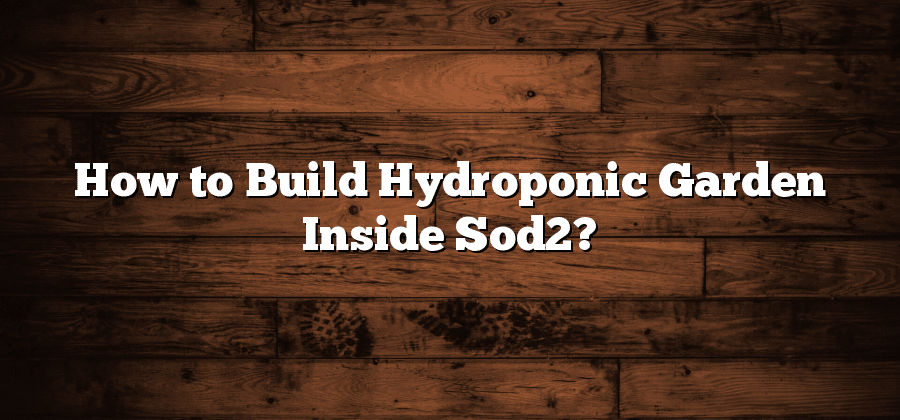Benefits of Building a Hydroponic Garden Indoors
One of the significant benefits of building a hydroponic garden indoors is the ability to control the environment in which your plants grow. Unlike traditional soil gardening, where factors like weather, soil quality, and pests can impact plant health, indoor hydroponic systems allow you to create the ideal conditions for your plants to thrive. By controlling variables such as temperature, humidity, lighting, and nutrient levels, you can optimize plant growth and maximize yields.
Another advantage of indoor hydroponic gardening is the ability to grow plants year-round, regardless of the season or climate. With the controlled environment provided by indoor systems, you can create the perfect conditions for your plants to grow and produce all year long. This is particularly advantageous in areas with harsh winters or limited outdoor gardening space. By growing plants indoors, you have the flexibility to cultivate a wide variety of crops and enjoy fresh, homegrown produce even during the colder months.
Selecting the Right Location for Your Hydroponic Garden
When it comes to selecting the right location for your hydroponic garden, there are several factors to consider. First and foremost, you need to find a space that receives adequate sunlight. Most hydroponic plants require at least 6 to 8 hours of direct sunlight each day to thrive. So, look for a location where sunlight is abundant throughout the day, such as near a south-facing window or under artificial grow lights.
Another important consideration is the availability of space. Your hydroponic garden will require enough room for the plants to grow and for you to maneuver comfortably. Assess the size of your available space and ensure it can accommodate the desired number of plants and the chosen hydroponic system. Additionally, consider factors such as temperature, humidity, and ventilation. The ideal location should have stable and controlled environmental conditions to provide optimal growing conditions for your plants. With a suitable location in place, you can set the stage for a successful and bountiful hydroponic garden.
Understanding the Basic Principles of Hydroponic Gardening
Hydroponic gardening has gained popularity in recent years as an innovative and efficient way to grow plants without soil. Understanding the basic principles of this gardening method is essential for any enthusiastic gardener looking to venture into the world of hydroponics.
One fundamental principle to grasp is that in a hydroponic system, plants receive their necessary nutrients directly through water, rather than from soil. The nutrient-rich solution is carefully balanced to meet the specific needs of each plant, ensuring optimal growth and development. Another key principle is that hydroponic gardening allows for precise control over environmental factors, such as water and nutrient levels, temperature, and lighting. This control helps to create an ideal growing environment, enabling plants to thrive and produce healthier yields. By understanding these basic principles, you can embark on your hydroponic gardening journey with confidence, knowing that you have the knowledge to achieve successful and sustainable results.
Choosing the Appropriate Hydroponic System for Your Sod2
When it comes to choosing the appropriate hydroponic system for your Sod2, there are several factors to consider. First and foremost, you need to evaluate the space available for your hydroponic garden. Different systems have different spatial requirements, so it is important to choose one that fits well within your available area.
Another important factor to consider is your level of experience and expertise in hydroponic gardening. Certain systems, such as the Deep Water Culture (DWC) or Nutrient Film Technique (NFT), require a higher level of skill and knowledge to set up and maintain. If you are a beginner, it might be best to start with a simpler system like the Wick System or the Drip System.
Additionally, you need to take into account the specific needs of the plants you plan to grow in your Sod2. Different hydroponic systems provide varying levels of control over factors like nutrients, pH levels, and water circulation. Research the requirements of your chosen plants and select a system that allows you to meet those needs effectively.
Lastly, consider your budget when choosing a hydroponic system. Some systems can be quite expensive due to the advanced technology and materials involved. However, there are also more affordable options available, so be sure to choose one that aligns with your financial resources.
By carefully evaluating these factors, you will be able to choose the appropriate hydroponic system for your Sod2 that best suits your space, expertise, plant requirements, and budget.
Gathering the Necessary Tools and Supplies for Your Garden
When it comes to setting up your hydroponic garden, having the right tools and supplies is essential for success. Before you begin, gather the necessary items to ensure a smooth and efficient gardening experience. First and foremost, you’ll need a quality pH testing kit to monitor the acidity or alkalinity of your nutrient solution. This will help you maintain the ideal pH level for your plants’ growth. Additionally, invest in a reliable electrical conductivity (EC) meter to measure the nutrient concentration in the water. Proper nutrient levels are crucial for the health and development of your plants.






